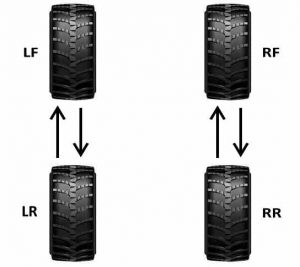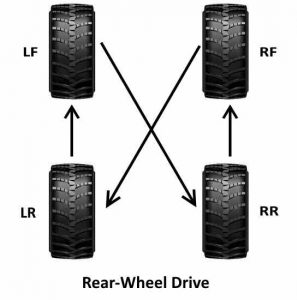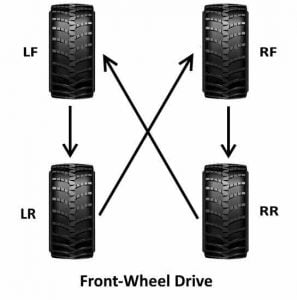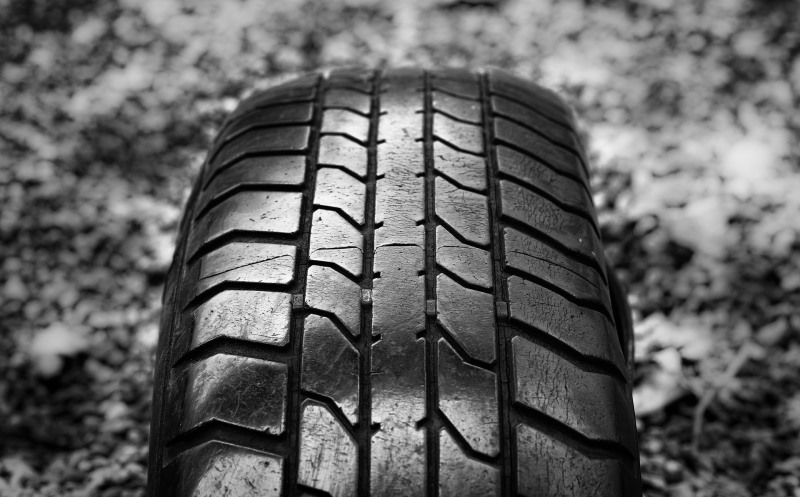Rotating your tyres means removing and re-positioning each tyre on your vehicle. This allows your tyres to wear evenly and last longer.
Why rotate your tyres?
Front and rear tyres wear differently. On most cars, the front tyres will carry much more weight, causing them to wear more quickly. In New Zealand, we also tend to take right turns more quickly than left turns. As a result of this, more pressure is put on the front-right and rear-right tyres.
Regular rotation of your tyres will equalise their wear patterns, allowing the tyres on your vehicle to last much longer. This will save you money as well as save you the stress of replacing a tyre.
What you will need:
- A tyre jack. (Ideally a high-quality jack rather than the one that comes with your car).
- A tyre wrench.
- Jacking stands (for supporting the car). If you do not have jacking stands, use large wooden blocks provided you can make them safe to support the vehicle.
- Wooden wedges to “chock” any wheels in place to prevent your car from rolling / moving while jacking up or while it is on the stands.
Determining where to rotate each tyre.
If you don’t already know, you will need to determine whether your tyres are directional or asymmetric. This will determine the rotation pattern you will need to follow.
Directional tyres are designed to roll in only one direction. They will have grooves that point in the tyre’s intended direction. These grooves will create a v-shaped pattern. When rotating directional tyres, you should switch the front-left and back-left tyres with each other, then switch the front-right and back right tyres with each other. This will preserve the intended direction of each tyre.

Non-directional or asymmetric tyres require a different approach. Since they aren’t designed for a specific direction, you can rotate them freely. However, we suggest you follow this rotation pattern for maximum tyre life. Rotate tyres on rear-wheel drive vehicles by moving the two rear tyres straight to the front (LR to LF and RR to RF). Then, move the front tyres diagonally (LF to RR and RF to LR).

Front wheel drive vehicles require an inverted approach. Move the front tyres backwards (LF to LR and RF to RR), then move the rear wheels diagonally (LR to RD and RR to LF).

1. Prepare your car.
Now that you have determined the ideal rotation pattern, you can begin the actual rotation process. Find a level surface to perform the tyre rotation. Unbalanced, hilly surfaces increase the risk of the vehicle tipping off the jack. Be sure to engage the parking brake and turn the vehicle off completely.
2. Remove the hubcaps and loosen the nuts on each wheel.
Most vehicles have hubcaps or wheel covers protecting the wheel nuts. If yours doesn’t, feel free to skip this step.
Use the flat end of your wrench to remove the hubcap from the tyre, exposing the nuts. If this doesn’t work, your vehicle may require a different tool. In this case, consult your vehicle’s manual for information.
Use a tyre wrench to loosen each nut by turning them counter-clockwise. This will make removing them much easier when the vehicle is on the jack.
3. Lift one wheel up using the jack and install the jacking stand.
Place the jack under an appropriate jacking point. For car-specific jacking point information, consult your manual. Use the jack to raise the vehicle so that it is high enough for you to place the jacking stand underneath it (next to the jacking point). Make sure that the jacking stand is secure before you remove the jack.
Depending on how many jacking stands you have, you will need to work out the order of how you are going to raise and lower your vehicle. More than two jacking stands will allow you to finish the job more quickly. If you have four jacking stands, you will be able to rotate all the tyres at once.
4. Begin swapping tyres.
Fully remove the nuts from the tyre you have raised, keeping track of where they are so you don’t lose them. You should now be able to remove the tyre (with a little bit of force). Repeat this process with other tyres and swap them according to the type of tyres and vehicle configuration you have (FWD or RWD).
5. Place the nuts and hubcaps on each tyre.
Use your wrench to place the nuts back on each wheel by turning them clockwise. Add and tighten the hubcaps to each wheel.
6. Lower the vehicle.
Raise the vehicle high enough so that you can remove the jacking stands from beneath its body. Once they are removed, you can use the jack to slowly lower each corner to the ground.
At Grimmer Motors, we are happy to rotate your tyres for you. Our experienced, qualified, trusted mechanics can also help you with:
- Puncture repair.
- Tyre replacement.
- Suspension.
- Wheel bearings.
- And much more…

